PLANT PEST
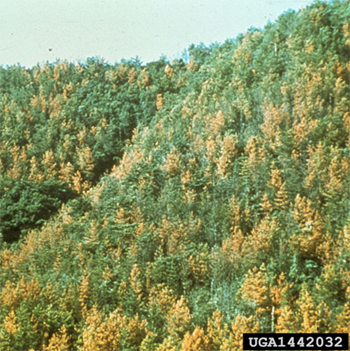
USDA Forest Service - Region 2 - Rocky Mountain Region, USDA Forest Service, Bugwood.org
Bursaphelenchus spp. (tree nematodes) and sawyer beetles (vector)
Exotic to Australia
Features: Nematodes (microscopic worms) that damage trees eventually leading to wilting, stunting and death of the tree. Sawyer beetles carry them.
Where they’re from: China, Japan, Korea, Malaysia, Portugal, Spain, Taiwan, and North, South and Central America.
How they spread: Importation of infested plants, plant material and soil; importation of insect vectors (an infected pine sawyer beetle) in timber and wood used for pallets and other packing materials. Local spread through infested plants, plant material, soil and movement of vectors.
At risk: Plantation forest and ornamental trees including pine, larch and spruce; palm species including oil, date and coconut.
Keep it out
Two species of microscopic worms known as nematodes are the target of biosecurity measures because of the damage they do to trees, the pine wilt nematode (Bursaphelenchus xylophilus) and red ring nematode (Bursaphelenchus cocophilus).
The pine wilt nematode causes pine wilt disease, typically killing pine trees within a few weeks to a month, as well as firs, cedars, larches, and spruces. The pine wilt nematode feeds within the aboveground parts of the tree, first causing needle to wilt and eventually death of the tree. So far it has proved impossible to control nematodes once introduced into a tree. Forests in Japan and USA continue to be devastated by the pest it causes huge losses in pine and other forestry trees.
The pine wilt nematode is spread by large, mottled, brown-grey beetles, known as pine sawyer beetles (Monochamus species). Several of these such as the Japanese pine sawyer and Carolina pine sawyer are not found in Australia.
The pine wilt nematode is a highly invasive species and threatens Australia’s pine forests.
Another nematode species, the red ring nematode, causes the lethal red ring disease in date, coconut and oil palms. The red ring nematode feeds on plant tissues leading to tree death within 2 – 4 months of infection. There is no record of any infested tree having recovered from the disease.
The red ring nematode is transmitted by Palm weevils (Rhynchophorus species) which are not found in Australia and are subject to restrictions to keep them out.
The red ring nematode is a highly invasive species and threatens Australia’s commercial and native palms.
Importing goods
To keep exotic species of nematode out of Australia, never ignore Australia’s strict biosecurity rules.
Import shipments may need to be treated and certified, so before you import, check our Biosecurity Import Conditions system (BICON).
What to look for
Since the nematodes themselves are almost too small to see, look out for dead and dying trees and signs of the nematode insect vectors.
For the pine wilt nematode, look for sick or dead pine trees or other forest trees. The trees will be wilting and browning across the whole tree or on a single branch. Also look out for the insect vector, the pine sawyer beetles, which grow up to 3 cm long with extra-long antennae, some longer than the beetles themselves.
Signs of the red ring nematodes are similar, with yellowing and browning leaves, wilting and death of palm trees. Also, a typical sign of infection is the presence of a distinct red ring of plant tissue in longitudinal cross section of the tree. In addition, be on the lookout for palm weevils, which vary in colour depending on the species, however, are generally 3-5cm in length and will be found tunnelling into the tree feeding and breeding in the plant tissue.
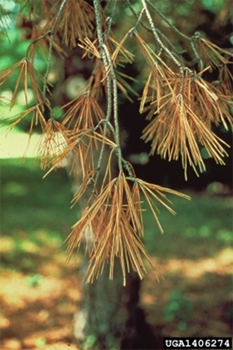
USDA Forest Service, Bugwood.org
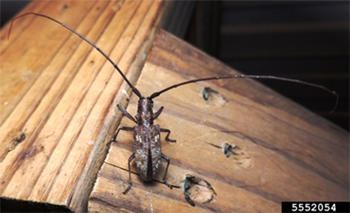
Royal Tyler, Pro Pest and Lawn Store, Bugwood.org
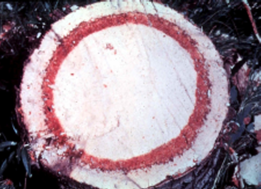
Society of Nematologists Slide Collection via UF/IFAS webpage https://entnemdept.ufl.edu/ Copyright: UF/IFAS
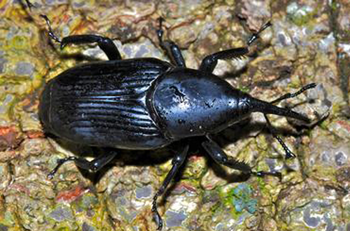
Bernard Dupont via Flickr
Where to look
Coconut palms and pine trees are the main targets of these exotic nematodes.
Importers
Importation of infested plants, plant material timber or soil is the most likely way that the nematodes would make it to Australia.
Pine sawyer beetles and palm weevils would be in infested timber or wood packing. Look for larval tunnels in the wood up to 1 cm wide, sawdust-like frass falling from damaged timber, and round exit holes about 1 cm wide.
Foresters and home gardeners
Look out for signs of these nematodes among your forest and palm trees, including trees that show signs of yellowing, browning, die-off of plant death. Also look for signs of the insect vectors such as larval tunnels in the wood and sawdust-like frass.
Look for symptoms in:
- pine
- fir
- cedar
- larch
- spruce
- coconut palm
- date palm
- ornamental and Australian native palms.
What to do
If you think you’ve found a plant infected with exotic nematodes or pine sawyer beetles:
- take a photo
- do not disturb infected plants (this may be as simple as closing the doors on a shipping container or preventing access to a part of the plantation)
- collect samples of beetles.
